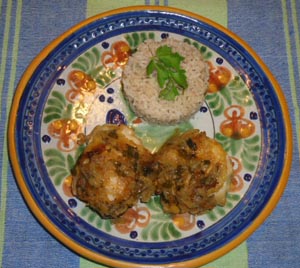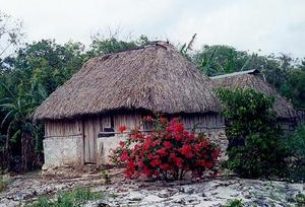Mexican Kitchen

As we settle into the crisp autumn months and adapt cooking techniques and ingredients to the change of seasons, it seems like a good time to look at the use of spices in the Mexican kitchen. Besides providing great depth of flavor, spices have both a warming and anti-inflammatory effect on the body, making them tasty and healthy additions to fall dishes.
In Mexico, the regional specialties prepared for late October and early November’s Day of the Dead offerings — from Puebla’s moles to the escabeche and chilmole of the Yucatan — rely on spices for their distinctive flavors. And spices also play a significant role in sweets for the upcoming holiday season.
But what exactly are spices and how are they different from herbs? The variety of fresh herbs used in Mexican cooking has been explored in some depth in this column (“A Culinary Guide to Mexican Herbs, Part One” and “Part Two“) and it turns out that some plants yield both an herb and a spice.
Culinary herbs are generally the leafy portions of a plant, and can be used either dried or fresh, though fresh is usually preferable. Cilantro and parsley, among countless others, are included in this category.
Spices, on the other hand, come from any other part of the plant and are usually used dried. They can be berries, like allspice and peppercorns; roots such as ginger; flower buds, like cloves; seeds, such as nutmeg; or flower stamens, in the case of saffron.
The very generous plants that give us both include cilantro, whose leafy greens are an indispensable herbal ingredient in Mexican food and whose seeds, called coriander (semilla de cilantro in Spanish) are a global favorite. And in the misty mountains of east central Mexico, where allspice trees flourish, cooks use the fragrant leaves as an herb, and the dried berry as a spice.
The lure of spices was an important impetus for the Age of Exploration, which brought the Spanish across the ocean, eventually to Mexico and onward to the Philippines. These spices were so highly prized that European monarchs financed exploratory voyages to find an alternate route to the East, the source of many of them.
The king and queen of Spain gave Columbus a letter of introduction to “the Great Khan” and, while he never found China, his expeditions yielded chiles, which eventually found their way around the world and are highly appreciated in many cuisines.
Cinnamon, cloves and other Eastern spices would have to continue coming from the East rather than the American continents, but Diego Chanca, a Spanish physician who traveled on one of Columbus’ voyages, was delighted to discover a tree that yielded a spice tasting like a combination of cinnamon, nutmeg and cloves. This was allspice, native to Latin America and the West Indies. The resemblance of the dried allspice berry to peppercorns gave it the rather confusing name of pimienta, the Spanish word for pepper.
Most of the spices, however, originated in the East, and the combination of these spices and indigenous herbs and chiles became a foundation for flavoring characteristic Mexican dishes. Many of the ingredients generally thought of as Mexican were brought to the New World from elsewhere, and it is difficult to imagine modern Mexican cuisine without cilantro, the herb brought by the Spaniards that gives us coriander; or cumin, a spice that originated in the Eastern Mediterranean region.
When we look at Mexican cookbooks through the ages, especially the historical ones lovingly reproduced by Mexico’s National Counsel for Culture and the Arts (CONACULTA) it is evident that the Mexican use of these onetime exotic spices began during the Colonial period. The 1780 cookbook of Fray Geronimo de San Pelayo remains one of my favorites, and his recipe for torta de arroz, or baked rice and picadillo, is well flavored with both herbs, such as parsley and mint, and a variety of fragrant spices, including saffron, cumin and ginger.
In Mexican cooking, several spices are used in both savory and sweet dishes. Anise and cinnamon seem to find their way into everything from moles to cookies, and even vanilla, usually considered a flavoring for sweets, is also used in shrimp and vegetable dishes.
When using spices, it is best to grind them, rather than using the pre-ground ones that come in a jar. The flavor is far superior and this method gives you the chance to control quantities. Most pre-ground spices will become stale long before you get to the bottom of that bottle. Any coffee or spice grinder will work, but dedicate it only to spices, or you may end up with some oddly flavored coffee.
Now that international cuisine has become so popular in Mexico, there are many spices sold today that were not easy to find even 25 years ago. Asian, Indian and Middle Eastern spices are now widely available, as chefs and home cooks explore these cuisines and incorporate them into menus.
The spices listed here, however, are those most frequently found in traditional Mexican cooking, along with some suggestions for using them. True herbs, those used for their green leaves, are not listed here, even if often sold in dried form, which is far inferior to fresh. English names for the spices are followed by botanical and Spanish names.
Allspice: Pimento dioica (pimienta gorda or pimienta de Tabasco)
Found in abundance in the Sierra Norte region of Puebla, allspice is used extensively in adobo and pipian as well as desserts. It is usually sold as a dried berry, resembling a peppercorn, from which it gets its name in Spanish. Add it to stews, soups, cakes and cookies.
Anise: Pimpinella anism (anís) and star anise: Illisium verum (anís estrella)
The seed of an herb in the parsley family, anise is distinguished by its licorice-like flavor and aroma, and is used in dessert cakes and especially cookies. It is a characteristic flavor in pan de muertos, Day of the Dead bread. The star anise is the small, dried fruit of an evergreen native to Asia. It is used in moles, especially mole poblano, and as a stomach remedy. In Mexico, a tea made from star anise is often given to colicky babies.
Annatto: Bixa orellana (achiote)
The seeds of a subtropical tree native to the Yucatan, annatto is used chiefly for its coloring, giving food a bright, reddish orange hue. Its scent is slightly sweet and peppery and its flavor subtle. Achiote is sold either as whole seeds or ground. Use it ground in Yucatecan dishes such as cochinita pibil, and mix it with other ground spices to make a rub for grilled meat, poultry or fish
Bay laurel: Laurus nobilis (laurel)
The dried leaves of the evergreen laurel tree, these Mediterranean natives are widely cultivated in Mexico, where they are harvested early in the day and dried in the shade to protect them from direct sunlight, which would draw out the essential oil. Use dried bay leaves in soups, stews and sauces. Avoid cooking with the fresh leaves, since they have a distinct menthol flavor that dissipates when dried and simmered, and store them in the freezer for a longer shelf life.
Capsicum peppers: Capsicum frutescens (chile)
Mexican chiles are just some of the many members of the capsicum family, which includes paprika, red pepper and cayenne. They cross the sometimes hazy line from fresh produce to spice when they are dried. If using whole, dried chiles, lightly toast and soak them first to soften, after which they need to be pureed in a blender with other ingredients. Ground versions, such as ancho or chipotle powder, are good in meat rubs.
Cinnamon: Cinnamomum zeylanicum (canela)
This cinnamon, sometimes called “true cinnamon” or Ceylon cinnamon, is the one most often used in Mexico, as opposed to cassia (Cinnamomum cassia) also known as “false cinnamon.” While cassia is sold and used as cinnamon in the United States, Mexican cooks prefer true cinnamon. Both are the dried inner bark of evergreen trees and are used in the same way for flavoring. In Mexican cuisine, use cinnamon everywhere from café de olla, or sweet spiced coffee, to moles and desserts. It is equally at home in both sweet and savory dishes
Clove: Syzygium aromaticum (clavo de olor)
Its Spanish name, which translates as “aromatic nails,” is quite apropos because of its distinct shape, which does resemble a carpentry nail. The clove is actually the dried flower bud of an evergreen tree native to Indonesia. It is considered the most important of the flower spices, rich in essential oils and used throughout the world for its strong flavor. In Mexico, it is an essential ingredient in pipian. Add a clove when making stock, and in baking.
Coriander: Coriandrum sativum (semilla de cilantro)
A star in Mexican cooking, this plant was used in the ancient world as early as 1550 BC in Egypt. Its leaves are the herb cilantro and its seeds the spice coriander. While use of the leaves is more widespread in Mexico, the seeds are ground and used in chorizo. Use coriander with cumin to intensify the spice flavor of Latin American dishes.
Cumin: Cuminum cyminum (comino)
A member of the parsley family, cumin is a small plant whose tiny, seed-like fruit is used as a spice. Especially popular in Latin American and Indian cuisines, cumin is a signature flavor in many Mexican dishes. As with other spices, it is best freshly ground. Use it in red enchilada sauce, moles and pipians.
Ginger: Zingiber officianale (jengibre)
The rhizomes, or underground stems, of a south Asian flowering plant, ginger can be used fresh or dried. Powdered, dried ginger is used in baking. Try adding it to Mexican piggy cookies (cochinitos) to replicate the flavor of gingerbread. In Mexico, ginger tea is used as a digestive.
Nutmeg: Myristica fragrans (nuez moscada)
The nutmeg tree of the East Indian archipelago produces two spices — the oily seed that is the spice called nutmeg, and the membrane that surrounds it, known as mace, a much less common spice. Nutmeg is often found in Mexican style hot chocolate and, on the savory side, is good in a sauce for chicken, as found in Marge Poore’s book 1,000 Mexican Recipes. Add nutmeg to sweet breads and muffins that call for cinnamon and allspice. Grinding nutmeg on a grater, such as a Microplane, is far superior to using pre-ground nutmeg.
Pepper: Piper nigrum (pimienta)
Often called the world’s most important spice, peppercorns are the small, round berries of a climbing vine native to southwestern India. Use whole peppercorns in making stock and ground pepper to season the outside of meat, poultry and fish. Invest in a decent pepper grinder and throw away the pre-ground stuff in the tin. Whole peppercorns are an essential ingredient in Mexican pickled chiles.
Saffron: Crocus sativus (azafran)
The dried stigma of a crocus flower, saffron is the most expensive spice in the world. Both the English and Spanish words for the spice come from the Arabic za’faran, meaning yellow. Saffron does indeed impart a bright, yellow orange color, as well as a distinctive flavor, to food. In Mexico, it is highly appreciated in rice dishes, a very traditional Spanish way of using it. Add it to garbanzo bean stew and to Mexican yellow rice. To use less of this pricy ingredient, try steeping it in hot water overnight to get bigger flavor from a small amount.
Sesame: Sesamum indicum (ajonjolí)
Said to be the oldest condiment known to man, sesame was cultivated in the Tigris and Euphrates valleys as early as 1600 BC. In Mexico, sesame is important in both cooking and agriculture, and is crucial in many moles and pipians. It is the traditional garnish for mole poblano, in addition to being ground in the sauce itself. The candy called pepitoria is made with sesame seeds, and they also adorn an array of sweet rolls. In the mountain region of western Veracruz state, the seeds are used — along with pumpkin seeds and chiles — to make tlatonile, a savory paste something like mole paste, which can be diluted to make a sauce, or added as a flavoring to soups and stews.
Vanilla: Vanilla planifolia (vainilla)
This Mexican native, originally cultivated by the Totonac people of eastern Mexico, is the cured pod of a flowering vine in the orchid family. For several centuries, Mexico remained the only vanilla producing country, until European botanists developed a method for pollination that did not depend upon the Mexican bees and hummingbirds that were crucial for its pollination in eastern Mexico’s misty, semitropical highlands. Use vanilla extract in baking and in poaching shellfish, especially shrimp and crawfish, as done in the Papantla region of Veracruz. Use the seeds scraped from the pod in chicken and vegetable dishes and in flan. It is worth it to buy pure vanilla extract and avoid the artificial version, a poor substitute.
The following recipes present a small cross section of Mexican dishes that are distinctly spice flavored with either one or a combination of spices.
- Mexican chicken with caramelized onions and nutmeg: Pollo con cebolla y nuez moscada
- Mexican rice with aromatic spices: Arroz con especias aromáticas
- Mexican anise cookies: Galletas de anis
- Colonial Mexican baked rice and picadillo: Torta de arroz
- Mexican turkey in piquant herb and spice broth: Pavo en escabeche
- Mexican honey spice bundt cake: Rosca de miel y especias
- Mexican chicken and allspice stew: Chilpozontle
- Mexican turkey in a dark spice sauce: Chilmole from the Yucatan


